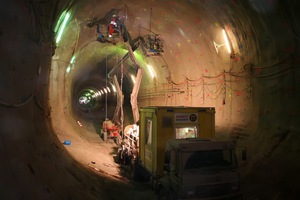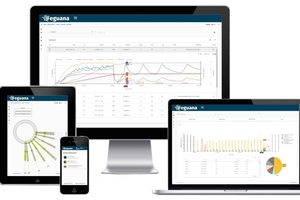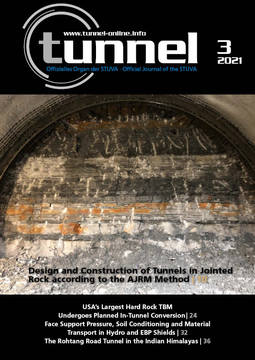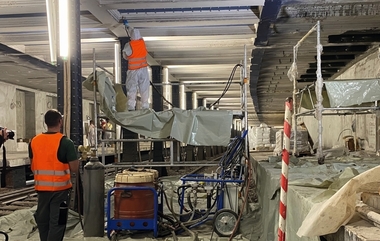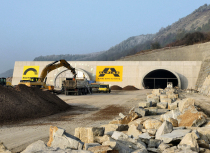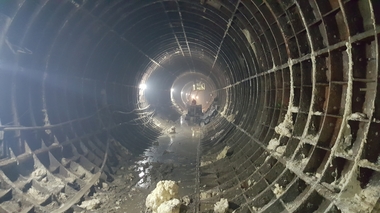Management and Analysis of the Surge of Digital Data for Injection Measures
If one considers an injection campaign for sealing fault zones in tunnelling with regard to the quantity of data obtained, one has to reckon with up to 500 injection points daily, or with, for example, three injection passes per metre and not infrequently 50 advance injection boreholes per round. Assuming a drilling depth of only 20 m, this already results in 3000 injections. For drilling and injection, equipment is used that records numerous measured values and parameters, such as different pressures and flow rates as well as rotation speed.
Calculated briefly, this means that for an average 30-minute injection alone, more than 5000 measured values are recorded and processed. That adds up to an incredible 1 000 000 readings for a comparatively conservative 200 injections. Every day. And this flood of data only concerns the logged series of readings from the injection operations. In addition, drilling data or, for example, construction process data, signs of wear and reactions of the rock also contribute to the accumulation of data. This gigantic amount of data results in two immediate problems for the tunnelling site concerned:
Efficiency
The issue of efficiency primarily concerns the senior staff on site: All this data does not normally collect itself. Generated by different devices, the data is often not easy to collect and must first be manually transferred to a spreadsheet programme such as Excel. The potential for errors is very high here: a typing error during manual entry, a wrong click during data import, a formula error or a wrong link ...
Afterwards, a series of diagrams are usually evaluated and protocols are created. These must not only be checked by the site manager, but must also be documented in a comprehensible form and then discussed with the planner and client.
How efficient is the work performance to be assessed if one has to work with such evaluations on a daily basis? And how much time is spent on evaluation and analysis that is urgently lacking elsewhere?
Safety
The question remains - why collect all this data at all? Or wouldn‘t it at least be enough to evaluate it only when necessary? After all, underground structures are „invisible“ to a certain extent, the structures are mostly hidden and faults cannot be seen with the naked eye or only at a late stage – not to mention the hidden dangers of the geology: fissures, groundwater rise, swelling rock – the list can be continued extensively.
Theoretically, problematic locations can be identified on the basis of the drilling and injection data, and in some cases it is even possible to draw conclusions about the geology behind them. For example, a sudden increase in flow rate in conjunction with decreasing pressure indicates unexpected fractures or the widening or, in the worst case, bursting of such a fracture. Occurrences that should ideally be responded to immediately.
How quickly a reaction is possible when the data first has to be entered into Excel, then manually evaluated and then discussed ... everyone can imagine that for themselves.
eguana Scales: Collection and Analysis
of Digital Construction Site Data on One Platform
In principle, several equipment manufacturers already offer suitable software to automatically collect and document the data from their equipment. However, the prerequisite for this is that equipment from only one manufacturer is used on the entire construction site and that there are no customer-specific requirements beyond the standard application.
The Austrian company eguana offers an alternative: The intuitive platform „Scales“ not only offers user-friendly and clear visualisation of the construction site – above all, it offers the possibility to collect all equipment data, regardless of type or manufacturer, in one system. The import takes place automatically and securely via the Internet. In the event of incorrect entry by the equipment operators or in the event of anomalies or errors in the process, the corresponding data records are automatically identified and marked.
In addition, the system offers automatic evaluations and analyses; potential problem areas are highlighted accordingly in the overview plan and data view. This makes it possible to see in real time where there is a need for checking. Since the system is accessible via browser, the relevant data is available to all parties involved at any time.
eguana Scales also offers new possibilities when it comes to billing. All quantities and times can be documented precisely and comprehensibly, and a bill of quantity can be exported directly for billing programmes.
Data quality and integrity increase, the potential for errors in the evaluation decreases. At the same time, the analysis and evaluation effort is massively reduced and time is freed up to concentrate on core activities. The safety of the structure increases because potential problems can be responded to quickly – and the safety for the companies involved also increases because complete documentation is available. The data can be processed further and serve as a basis for calculation for future projects.

